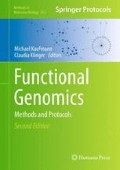Abstract
Technological advances in the field of microarray production and analysis lead to the development of protein microarrays. Of these, antigen microarrays are one particular format that allows the study of antigen–antibody interactions in a miniaturized and highly multiplexed fashion. Here, we describe the parallel detection of antibodies with different specificities in human serum, a procedure also called antibody profiling. Autoantigens printed on microarray slides are reacted with test sera and the bound antibodies are identified by fluorescently labeled secondary reagents. Reactivity patterns generated this way characterize individuals and can help design novel diagnostic tools.
Access this chapter
Tax calculation will be finalised at checkout
Purchases are for personal use only
References
Jung D, Giallourakis C, Mostoslavsky R et al. (2006) Mechanism and control of V(D)J recombination at the immunoglobulin heavy chain locus Annu. Rev. Immunol. 24:541–70
Wu X, Feng J, Komori A et al. (2003) Immunoglobulin somatic hypermutation: double-strand DNA breaks, AID and error-prone DNA repair J. Clin. Immunol. 23:235–46
Prechl J, Papp K, Erdei A. (2010) Antigen microarrays: descriptive chemistry or functional immunomics? Trends Immunol. 31:133–7
Cahill DJ, Nordhoff E. (2003) Protein arrays and their role in proteomics Adv. Biochem. Eng Biotechnol. 83:177–87
Robinson WH. (2006) Antigen arrays for antibody profiling Curr. Opin. Chem. Biol. 10:67–72
Feinberg JG. (1961) A ‘microspot’ test for antigens and antibodies Nature 192:985–6
Graham KL, Robinson WH, Steinman L et al. (2004) High-throughput methods for measuring autoantibodies in systemic lupus erythematosus and other autoimmune diseases Autoimmunity 37:269–72
Lueking A, Huber O, Wirths C et al. (2005) Profiling of alopecia areata autoantigens based on protein microarray technology Mol. Cell Proteomics. 4:1382–90
Hueber W, Kidd BA, Tomooka BH et al. (2005) Antigen microarray profiling of autoantibodies in rheumatoid arthritis Arthritis Rheum. 52:2645–55
Kanter JL, Narayana S, Ho PP et al. (2006) Lipid microarrays identify key mediators of autoimmune brain inflammation Nat. Med. 12:138–43
Hiller R, Laffer S, Harwanegg C et al. (2002) Microarrayed allergen molecules: diagnostic gatekeepers for allergy treatment FASEB J. 16:414–6
Bacarese-Hamilton T, Mezzasoma L, Ingham C et al. (2002) Detection of allergen-specific IgE on microarrays by use of signal amplification techniques Clin. Chem. 48:1367–70
Gaseitsiwe S, Valentini D, Mahdavifar S et al. (2008) Pattern recognition in pulmonary tuberculosis defined by high content peptide microarray chip analysis representing 61 proteins from M. tuberculosis PLoS. One. 3:e3840
Mezzasoma L, Bacarese-Hamilton T, Di CM et al. (2002) Antigen microarrays for serodiagnosis of infectious diseases Clin. Chem. 48:121–30
Davies DH, Liang X, Hernandez JE et al. (2005) Profiling the humoral immune response to infection by using proteome microarrays: high-throughput vaccine and diagnostic antigen discovery Proc. Natl. Acad. Sci. USA 102:547–52
Casiano CA, Mediavilla-Varela M, Tan EM. (2006) Tumor-associated antigen arrays for the serological diagnosis of cancer Mol. Cell Proteomics 5:1745–59
Madoz-Gurpide J, Kuick R, Wang H et al. (2008) Integral protein microarrays for the identification of lung cancer antigens in sera that induce a humoral immune response Mol. Cell Proteomics 7:268–81
Papp K, Szekeres Z, Terenyi N et al. (2007) On-chip complement activation adds an extra dimension to antigen microarrays Mol. Cell Proteomics 6:133–40
Acknowledgments
This work was supported by the Hungarian Academy of Sciences, grant KMOP-1.1.1-08/1-2008-0028 from the National Development Agency and NKTH-OTKA grant K68617. K.P. is supported by Janos Bolyai Research Fellowship. We thank Zoltán Szittner and Mariann Kremlitzka for their critical comments.
Author information
Authors and Affiliations
Corresponding author
Editor information
Editors and Affiliations
Rights and permissions
Copyright information
© 2012 Springer Science+Business Media, LLC
About this protocol
Cite this protocol
Papp, K., Prechl, J. (2012). The Use of Antigen Microarrays in Antibody Profiling. In: Kaufmann, M., Klinger, C. (eds) Functional Genomics. Methods in Molecular Biology, vol 815. Springer, New York, NY. https://doi.org/10.1007/978-1-61779-424-7_14
Download citation
DOI: https://doi.org/10.1007/978-1-61779-424-7_14
Published:
Publisher Name: Springer, New York, NY
Print ISBN: 978-1-61779-423-0
Online ISBN: 978-1-61779-424-7
eBook Packages: Springer Protocols

